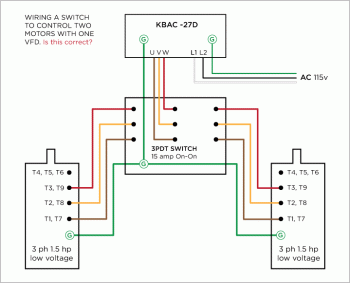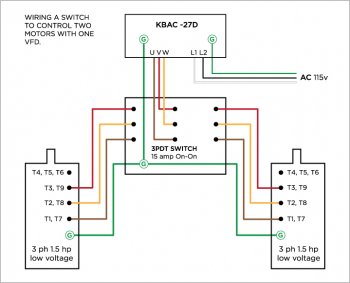jspake
Well-Known Member
hi folks,
i am moving into my new shop (garage at home beats paying for shop space!) and in anticipation of buying a 2nd grinder in the near future, i decided to build a switch to go between two grinders on my KBAC-27D VFD. i have been using this VFD with a 3ph 1.5 hp motor, running it with low voltage 115 wiring with great success on my KMG with for a few years. i purchased a new motor with identical specs to be used on the new grinder. last night i finished building the switch, thanks to many threads i have found on the subject on the various message boards. i checked and double checked everything, and then ran a test.
POOF. a pop. it took me longer than i'd like to admit before i figured out that it was my GFCI that blew, and not my VFD, etc... i then did some research to discover that these VFDs do not work on a GFCI circuit. so tonight i was about to go down and swap the 1st and 2nd outlets, so i could run my grinders on an outlet between the breaker and the GFCI, subsequently being moved to the 2nd position in the circuit... and then i realized something important.
i'm still not 100% sure that my wiring is correct, and it REALLY COULD BE that the GFCI is tripping and actually protecting me because of an error that i have made. i guess this thought materialized because i expected that when i ran my disc grinder, which is controlled by a KBAC-24 it did NOT trip the GFCI, and i'd read that it would. i know very little about this sort of thing, and what i do "know" has been gleaned from online sources, aka you guys. i drew up my wiring scheme and posted it to this message. if some of you know a bit about this, would you mind taking a look at what i've got, and see if it looks legit?

i am moving into my new shop (garage at home beats paying for shop space!) and in anticipation of buying a 2nd grinder in the near future, i decided to build a switch to go between two grinders on my KBAC-27D VFD. i have been using this VFD with a 3ph 1.5 hp motor, running it with low voltage 115 wiring with great success on my KMG with for a few years. i purchased a new motor with identical specs to be used on the new grinder. last night i finished building the switch, thanks to many threads i have found on the subject on the various message boards. i checked and double checked everything, and then ran a test.
POOF. a pop. it took me longer than i'd like to admit before i figured out that it was my GFCI that blew, and not my VFD, etc... i then did some research to discover that these VFDs do not work on a GFCI circuit. so tonight i was about to go down and swap the 1st and 2nd outlets, so i could run my grinders on an outlet between the breaker and the GFCI, subsequently being moved to the 2nd position in the circuit... and then i realized something important.
i'm still not 100% sure that my wiring is correct, and it REALLY COULD BE that the GFCI is tripping and actually protecting me because of an error that i have made. i guess this thought materialized because i expected that when i ran my disc grinder, which is controlled by a KBAC-24 it did NOT trip the GFCI, and i'd read that it would. i know very little about this sort of thing, and what i do "know" has been gleaned from online sources, aka you guys. i drew up my wiring scheme and posted it to this message. if some of you know a bit about this, would you mind taking a look at what i've got, and see if it looks legit?

Last edited:

